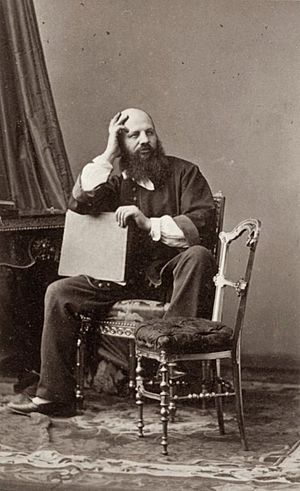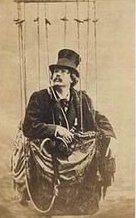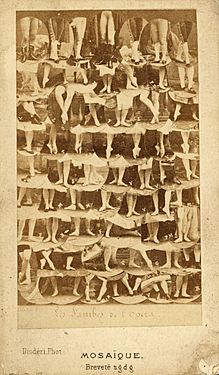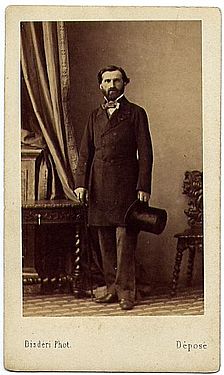André-Adolphe-Eugène Disdéri facts for kids
Quick facts for kids
André Adolphe-Eugène Disdéri
|
|
|---|---|

Self-portrait, c. 1860 (Paris, Musée d'Orsay)
|
|
| Born | 28 March 1819 Paris, France
|
| Died | October 4, 1889 (aged 70) Paris, France
|
| Occupation | Photographer |
| Years active | 1846–1870 |
| Known for | Photographic career as a daguerreotypist |
| Signature | |
 |
|
André Adolphe-Eugène Disdéri (28 March 1819 – 4 October 1889) was a famous French photographer. He began his career taking pictures called daguerreotypes. But he became much more famous for creating his own version of the carte de visite. This was a small photograph attached to a card. Disdéri was very good at promoting his ideas. He made this way of taking many portraits very popular around the world.
Contents
Early Photography Adventures
Disdéri worked in different jobs and also studied art. He started taking daguerreotypes in Brest around 1848 or 1849. Later, in 1852 or 1853, he moved to Nîmes. There, he got help from other scientists with his photography experiments. After a year, he moved to Paris. This move made it easy for him to find many people who wanted their pictures taken for his new cartes de visite.
The Amazing Carte de Visite

Before Disdéri, photographs were sometimes used as calling cards. But Disdéri's invention of the paper carte de visite (which means "visiting card") changed everything. It allowed for photos to be made in huge numbers. On November 27, 1854, he got a patent for his system. This system could print many photos on one sheet. This was the very first patent for a carte de visite.
Disdéri's cartes de visite were about 6x9 centimeters. This was similar to the size of regular visiting cards back then. He used a special camera with four lenses. This camera also had a sliding plate holder. Its design was inspired by stereoscopic cameras, which create 3D effects.
This new idea quickly spread everywhere. A visitor from Germany said that Disdéri's studio became "the Temple of Photography." It was known for being very fancy and elegant. He sold thousands of portraits every day!
These photos were cheap to make and could be copied many times. This made the older daguerreotype photos less popular. Soon, a carte de visite craze swept across Europe and the United States. Everyone in Paris wanted their portrait taken.
Even Nadar, another great French photographer and Disdéri's rival, wrote about this new invention. He said that when Disdéri and the carte de visite appeared, it was a "disaster" for other photographers. He felt they had to either follow the trend or give up.
The Twin-Lens Camera
Disdéri also invented the twin-lens reflex camera. This type of camera uses two lenses. One lens is for taking the picture, and the other is for the photographer to see what they are shooting.
Later Life and Legacy
After the Paris Commune in 1871, Disdéri took a famous picture. It showed people who had died during the conflict.
At the peak of his career, Disdéri was very rich and well-known. But like another famous photographer, Mathew Brady, he reportedly died without much money. He passed away on October 4, 1889. He was a victim of his own success. The system he invented was so easy to copy. Photographers all over the world started using it, which made it harder for him to keep his wealth.
Gallery
-
"Les Jambes de l'opera, Mosaïque Breveté s.d.g.d.", c. 1862. Los Angeles, Getty Center.
-
Portrait de Giuseppe Verdi, au format carte-de-visite. Paris, Musée d'Orsay.
-
Emperor Napoleon III et Empress Eugénie (c. 1870), Los Angeles, Getty Center.





